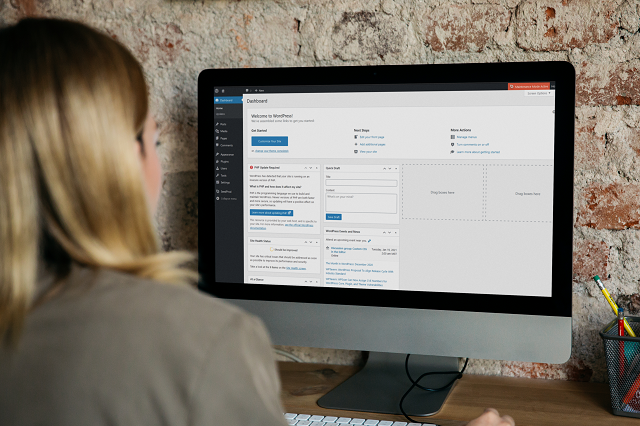It’s no secret that nearly 5 billion people across the world have access to the internet. From mobile devices to desktops, it seems like everyone these days is plugged in — and if your business isn’t claiming space on the web, then you’re missing out on oodles of potential customers. No matter your niche or where you’re located, it’s essential to start a website for your business.
With a website, you can sell products or services online, establish yourself as a thought leader in your industry, generate new leads for your business, reach and connect with customers, and give your brand the visibility it deserves.
Are you on board yet? Good, because having a website is important, but building one that suits your needs and is functional for potential visitors is the end goal.
Editor’s note: Want to get a head start on building your website? Websites + Marketing is here to help.
Start a website in 5 steps
For the remainder of this post, we’ll cover everything you need to know to build a highly effective website — from getting started by establishing achievable goals, to creating a content-rich website that both visitors and search engines will love. We’ll take a look at what you need to know to sell online. We’ll introduce tools that will help you achieve your website goals. And we’ll divvy out tips and best practices to make your website work at maximum capacity.
-
Plan your website.
-
Design your site — DIY or DIFM?
-
Create amazing content.
-
Sell on your website.
-
Get found with SEO.
Now that you want to start a website, we want to help you succeed. Ready? Let’s go.
1. Plan your website

Before you can dive into the nitty-gritty of website creation, you need to map out a plan for success. Even if you already have an established brick-and-mortar store, taking that identity to the web requires a bit of foresight.
Establish concrete goals
If you’re looking to break into the online scene, you’ll first need to define your purpose. It’s not enough to say, “I want to sell online,” or “I want a website.” Rather, ask yourself, “What do I want my website to accomplish for my business?” Perhaps it’s revenue or monthly visitors. Regardless of the metric you choose, make sure it aligns with your overall brand.
Crafting measurable, attainable goals gives you a way to track your company’s success. Instead of saying, “I want a million followers on Twitter by the end of my first year,” break it down into quarters (and maybe start with a smaller number).
Not sure where to start? Here are some things to consider:
- Keep your goals realistic.
- Make sure they’re well-defined.
- Align them with your business’s mission.
- Ensure they’re measurable.
- Set a time limit for each goal.
The purpose here isn’t to confine or stifle you — there’s merit in dreaming big. But if you set lofty goals before you have the platform to achieve them, you run the risk of low morale, which only hinders your output. And remember, you’re building this site to put your business in front of billions of online users. Clearly defining your goals ahead of time makes it easier to connect with your target audience.
Define your audience
As appealing as it sounds to cater to the three billion users online, it’s not reasonable. Those three billion users are unique individuals with tastes that vary wildly, so you’re better off targeting people who closely align with your business’s niche in the marketplace. It’s important to get granular with your online presence so you can better connect with potential consumers.
What kind of site are you building? Do you want to be humorous or serious? Are you selling mint-condition bobbleheads or offering legal advice? Knowing who your audience is, and appropriately tailoring your language to their needs, means you’ll have a better chance of encouraging them to act — and by that we mean buying, subscribing, sharing or whatever your desired end result might be.
Pique your audience’s interest
Let’s say you want to start a website to sell custom printed T-shirts with wacky images and humorous catchphrases. How are you going to appeal to customers — both existing and new — when it comes to your products? You probably wouldn’t lean on dry text when trying to describe your fun logos. Let’s take a look at two options and see which one you’d prefer:
Option 1: Try our cotton-blend men’s T-shirt. Sixteen different colors available in six sizes, ranging from XS to XXL. Features a cute sneezing panda on the front.
Option 2: Woven with the craftiness of Rumplestilskin himself, these comfortable T-shirts will softly caress your skin for a guaranteed 24 hours. The sneezing panda will definitely make you an internet sensation — for a limited time.
Which do you think your audience would prefer? Why are they visiting your site? But most importantly, which option will encourage your consumers to act? It’s not the same for every business, so don’t be afraid to test out different methods until you land on the right one.
Define your audience
Complete the following fields to get a better picture of who your target audience is:
- Age and gender: (i.e., Women over the age of 20)
- Interests and hobbies: (i.e., Skateboarders)
- General location: (i.e., Northeastern states)
- Personality and attitude: (i.e., Humorous)
- Occupation and income: (i.e., College student, less than $40,000 a year)
This combination of demographic and psychographic information will help you narrow down your audience, even giving you the opportunity to tailor content and potential products to make acting — buying, sharing, subscribing — easier for consumers.
Pick a domain name
Picking a domain name isn’t to be taken lightly. Whether you’re starting a brand-new business or already have an established company, one thing stands true for both — your domain name should represent your brand. And since there are almost two billion websites currently on the internet, that means finding the perfect domain name might be a tad difficult.
Don’t limit yourself by looking only for domains ending in .com. There are hundreds of new geo- and industry-specific domain extensions that can help you score a domain name that perfectly represents who you are, what you do, and where you do it.
If you’re starting an ecommerce site, consider a domain name ending in .shop or .store. Attorney? Check out .legal and .lawyer domains. In the pet services industry? Snag a domain name ending in .pet. Plumber? There’s a .plumbing domain name that’s just right for you. The sky’s the limit with the availability of these new generic top-level domain extensions (gTLDs).
Above all, an effective domain name should do the following things for your business (regardless of the extension you choose):
- Safeguard your brand.
- Accurately represent who you are and what you do.
- Grab the attention of your visitors.
Simple, right? Let’s take a look at some helpful tips for choosing the perfect domain name.
10 tips for choosing the perfect domain
- Make it easy to type. You don’t want your visitors ending up somewhere else because you added a silent “T” to your name.
- Keep it short. Supercalifragilisticexpialidocious is better left to Mary Poppins.
- Use keywords. If you can, incorporate the product or service you offer.
- Target your area. Consider using your geo-location to your advantage.
- Avoid numbers and hyphens. These keys aren’t typed as frequently as the alphabet — don’t make people work to find you.
- Be memorable. Standing out from the crowd is good thing.
- Research it. Don’t grab the first name you think sounds catchy — test among your friends and family first.
- Use an appropriate domain extension. Don’t get stuck in the .com mindset.
- Protect and build your brand. Consider registering multiple variations to safeguard your brand.
- Act fast. New domains are registered every day — don’t wait too long, or yours might get snatched.
Go for it!
Research design ideas

So now that you’ve established your goals, determined your audience, and selected a domain name, it’s time to create, right? Almost. Before you pick up the design tools and start a website, do some recon.
A good place to start is by looking at your competitors’ websites. Pay attention to:
- The fonts and colors that appeal to you.
- The layout and overall feel of the site.
- The use of videos, images and other graphics.
- The amount of pages present.
- The amount of copy or text on each page.
- Whether or not it’s easy to navigate.
- Whether or not it’s optimized for mobile devices (all of them should be).
Do these sites feel clunky or clean? Will the end-user be able to navigate easily through the site so they can perform the desired action? Overall, your goal is to note what works and what doesn’t so you can make educated design decisions moving forward. Make a list of your favorite design elements and keep them close at hand so you’re ready to move to the next step.
Remember: Trends change rapidly. Be prepared to revisit your site every few years to make sure it’s on par with industry standards.
Quick checklist: Plan your website
Let’s recap your first few steps for starting a website:
- Write down your business goals.
- Define your audience.
- Brainstorm domain names.
- Search and register domain(s).
- Research design ideas.
- Make a list of favorites for reference.
Time to plan a website: 1 to 3 hours.
2. Design your site — DIY or DIFM?
So by now, you totally understand that building a website for your business is important and you’ve nailed down the planning fundamentals. But what do you do next? The good news is, you have options. You can either start a website yourself (DIY) or hire a professional to do it for you (DIFM). But before we weigh the pros and cons of those avenues, let’s first talk about the foundation of your website — your hosting.
Consider your hosting options
Imagine your website as a house. Your domain is the street address, and the plot of land beneath your structure is your hosting plan.
No matter how solid your house is, if the foundation beneath it is weak, you’re going to run into problems.
A good hosting platform, regardless of whether you build a website yourself or hire a pro to do it for you, is essential for solid performance. Whether you opt for a simple DIY website builder or use a Content Management System (CMS) like WordPress, the behind-the-scenes hosting needs to be up to snuff.
Before purchasing a hosting plan, here are a few things to consider:
Reliability. Even if your site is optimized for speed, your host’s uptime could affect your site’s load time and accessibility. Pay close attention to the guarantees each company offers.
Support. What happens when your site goes down at 2 a.m.? Will you be able to reach your hosting provider, or will you have to wait until the following day to find a solution? That valuable time off the internet could potentially hurt your business. Look for a provider with 24/7 support.
Storage. Storage is largely dependent on the type of site you’re going to build. Are you a photographer in need of displaying your online portfolio? If so, those images are going to use a lot of space. While some places offer “unlimited” storage, be sure to read the fine print.
Bandwidth. Bandwidth and storage go hand-in-hand. The larger website you have, the more data you’re going to transfer to visitors upon arrival, and the more bandwidth you’ll need.
Scalability. We all want tons of traffic, right? Right. Make sure your hosting company can handle your expected amount of visitors. The last thing you want is an influx of traffic only to have your site crash.
Security. Getting hacked is no joke. Malware and viruses can seriously damage your online reputation. Look for hosting plans that either incorporate some level of security or companies that offer website security as an add-on.
Backups. Unexpected problems happen all the time. If something goes wrong with your site, you can use your backups to restore it. Check to see if your hosting provider offers website backup or a way to add them to your plan.
Note: If you opt for a site builder, most companies include hosting as part of their package. Check to be safe so you don’t buy products you don’t need.
Build your site: DIY

Now it’s time for the fun stuff — building your website. There are a couple of different ways to go about it if you’re looking to build a site yourself, but for the sake of this article, we’ll narrow it down to two of the most popular options: using a website builder or WordPress.
WEBSITE BUILDER
If you consider yourself non-technical and you don’t have the funds to hire a professional, then a website builder is the way to go. Add pictures, customize pages, integrate with Facebook, add email marketing and more — all with an easy-to-use swipe-to-style interface. You can even build your site on your mobile device in under an hour. Plus, Websites + Marketing automatically optimizes your site for search engines to improve your ranking.
Our recommendation: Website builders are great for entrepreneurs and small business owners looking to establish an online presence quickly. They’re easy to use, require little to no technical knowledge, and are a great way to start a website.
WORDPRESS

If you want more flexibility and control of the behind-the-scenes aspect of your website, then WordPress is the way to go. Just keep in mind that WordPress requires a bit more technical skill than your go-to drag-and-drop builder. While you don’t need to learn coding right out of the box, there are hundreds of plugins, features and options that could provide added functionality if you’re willing to put in the time.
Over 34% of the internet has selected WordPress for their site-building needs, and there are tons of resources available to you.
With WordPress hosting option, you can dive into building with a simple and easy Quick Start Wizard. Before you know it, you’ll be online!
Our recommendation: WordPress is a perfect option if you’re looking for more customization out of your website. There are thousands of plugins and widgets available to boost functionality. If you’ve got the time to tackle the slight learning curve, WordPress is a great solution for your business website.
DIY design tips
Keep these quick tips in mind when designing your site:
- Use a clean and simple design.
- Choose a color scheme that matches your brand or logo.
- Use high-resolution, quality images.
- Choose a font and style that’s easy to read.
- Make navigation clear and easy.
- Include well-crafted web content.
- Don’t forget a contact page.
- Make sure your site is mobile-friendly.
- Prominently display links to your social profiles.
- Optimize for search engines like Google.
Build your site: DIFM
If you would rather spend your efforts focusing on what you do best — running your business — and have a budget for website design, hiring a professional web designer might be the way to go. Just like you are the only person who can run your business, professional web designers possess a unique set of skills and talents they use to run theirs.
Want to put a professional team in charge of creating and managing a beautiful business website for you? If so, then Website Design Service is a great place to start. They’ll create, host and update your site quickly and affordably, so you can focus on what you do best.
The design team will also ensure that your site is fully optimized for search engines and will also manage your business social media accounts as well. Additionally, unlimited site updates are built into most plans, so your website can be easily kept up to date.
Once you’ve selected the Web Design Services plan that best fits your business needs, you would then choose a theme that fits your business and give your web designer the basic information about your site. With a website from the Professional Web Services Team, you simply provide the content and images; they handle everything else.
Quick checklist: Design your site
Ready to move on to the next section? Make sure you’ve completed these tasks:
- Determine DIY or DIFM
- Compare options using worksheet
- DIY: Site builder or WordPress?
- DIFM: Research/hire a pro
Time to design your site: A few days
3. Create amazing content

Whether you want website visitors to sign up for a newsletter, purchase a product, share on social media or anything in between, you need to present content that compels them to act. Well-crafted words, paired with eye-catching images, can make all the difference. That’s how you make your story shine online.
Your business story
Even if you don’t fancy yourself a skilled writer, you can craft amazing content that speaks to your business and your brand. That content can be as simple as:
- Sharing how you started your business.
- A photo or video of you / your team in action.
- The methods behind building your products.
- Interesting descriptions of your services.
- An anecdote that demonstrates how your products or services are benefiting customers.
The choice is yours. To start, all you need is content for five core pages (you can always expand later).
Five core pages
Home. This is your landing page, and it needs to wow visitors from the get go. Craft content that invites visitors to explore further and encourages them to act.
About Us. There’s no better place to tell your business story than on your About Us page. Explain how you got started to show your visitors the people behind the brand.
Products/services. The bread and butter of why you’re starting a website. Remember that images, as well as content, paint a story. Make sure any product photos you use stand out.
Testimonials. It’s important for visitors to see that your product and brand can be trusted. Use testimonials to share the customer perspective of your business.
Contact Us. Give your visitors a way to contact you. Show them that you can be reached, answer questions promptly, and inspire trust by being more than a brand.
Write your own web content
Now onto the really fun stuff — writing your own web content. Don’t fret! No one knows your business better than you. You know your story, you have a unique voice, and you can inspire trust in customers, regardless of your previous writing skills. Crafting content doesn’t have to be difficult, and we’ve got a few tips to steer you in the right direction.
Audience. If you haven’t done so already, nail down your audience. Understanding the type of visitors you intend to engage with is key to creating relevant content. Prioritize your content to match with their unique needs, and make sure your content not only explains what you do, but why you’re the better option than your competitors.
Voice. Once you’ve determined your audience, you can tailor your voice to match both your brand and your customers. You wouldn’t run a law website and use humorous language to describe divorce proceedings, and likewise if you’re selling fun kids T-shirts, you wouldn’t use stiff text to describe your products. Be true to your brand, and the rest will naturally fall into place.
Layout. Do your eyes glaze over when you see a big block of text? Mine do. The layout of your content is just as important as the words themselves. Use images, white space, lists and headings to spread out your information in a way that is pleasing to the eye.
Have fun! This is the most important step — have fun with your words! Don’t be afraid to test out different methods and go with the one that works best for your customers (and you).
Pro tip: When you’re done with your web content, get an outside pair of eyes on your words (preferably someone with editing experience). Even with a humorous site, you want to be professional, so don’t let grammatical or mechanical errors hold you back.
Using images on your website

Part of a standout content strategy includes incorporating captivating images. In fact, “BuzzSumo found that articles with an image once every 75 to 100 words received double the social media shares as articles with fewer images.” So if you want your readers engaged, start including images. Here are a few things to remember when it comes to selecting photos for your website:
Don’t use images illegally. You can’t just run to Google and copy the first photo you see. Stick to places like Pixabay or Unsplash for stock photos if you don’t have the means to take your own. Provide attribution as needed.
Use high-quality images. Beautiful images can inspire action. Don’t turn customers away with shaky photos. Pick or take photos that relate to your brand and resonate with your audience.
Optimize your images. Keep reading through this guide to learn more about image optimization. For starters, make sure they’re sized appropriately, compressed so they don’t affect load time, and are named with relevant keywords.
Outsourcing web content
Still not convinced that writing your own content is the way to go? Consider outsourcing. There are plenty of sites, like UpWork or Fiverr, that make it easy to hire a freelancer for your content needs.
Pros:
- There are plenty of options, giving you the ability to be selective with who you hire.
- You can specifically choose someone with writing and editing skills.
- You can post your job and set your budget on your own terms.
- Hiring a pro gives you more free time to handle other business tasks.
Cons:
- Hiring an outsider to tell your story might not result in your desired voice.
- You might have to revisit the final product and add some of your own personal flair.
- Hiring someone is always more costly than writing content on your own.
- You’ll be relying on someone else to meet a deadline (rather than yourself).
Pro tip: If you decide to hire a pro, arm them with insight about your business from the get-go — how you got started, inspiration behind the products, etc. The writer’s job is to work with the raw material you provide.